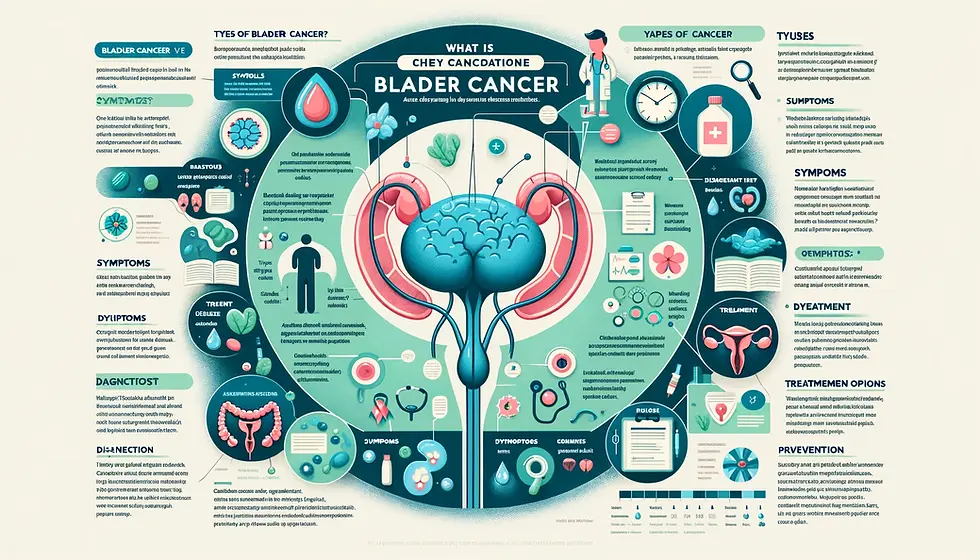Bladder Cancer Types, Symptoms, Diagnosis, and Treatment
- Doctoury
- May 24, 2024
- 2 min read
Bladder Cancer Types, Symptoms, Diagnosis, and Treatment Options
Bladder cancer is a significant health concern worldwide, affecting numerous individuals each year. This blog aims to provide comprehensive insights into what bladder cancer is, its various types, causes, symptoms, diagnostic processes, treatment options, and prevention methods. Our goal is to equip you with the knowledge necessary to understand and potentially reduce the risk of this disease.
Bladder cancer starts in the cells of the bladder, the organ that stores urine. It is one of the most common types of cancer, with several variations based on how the cancer cells appear under a microscope. Understanding bladder cancer is crucial for early detection and effective treatment.

The three main types of bladder cancer are:
Urothelial Carcinoma: Accounting for about 90% of all bladder cancers, this type starts in the urothelial cells lining the bladder.
Squamous Cell Carcinoma: This type develops after prolonged inflammation or irritation in the bladder.
Adenocarcinoma: A rare form of bladder cancer, adenocarcinoma begins in the mucus-producing glandular cells of the bladder.
The exact cause of bladder cancer is unknown, but several risk factors increase its likelihood:
Smoking: The most significant risk factor, smoking can double the risk of bladder cancer.
Chemical Exposure: Certain industrial chemicals have been linked to higher bladder cancer rates.
Chronic Bladder Inflammation: Chronic infections or irritants may lead to squamous cell carcinoma.
Personal or Family History: A family history of bladder cancer can increase risk.
Recognizing the symptoms early can lead to a better prognosis. Common symptoms include:
Blood in Urine: The most common symptom, often painless and visible.
Frequent Urination: An increased need to urinate without results.
Painful Urination: Discomfort or pain during urination.
Pelvic Pain: Pain in the lower part of the pelvis near the bladder.
Early diagnosis can significantly improve treatment outcomes. Diagnosis usually involves:
Urinalysis: Checking for blood or abnormal cells in the urine.
Cystoscopy: A doctor inserts a narrow tube with a camera to see inside the bladder.
Biopsy: Taking a small tissue sample during cystoscopy for testing.
Imaging Tests: Ultrasounds, CT scans, and MRIs can help determine the extent of cancer.
Treatment depends on the cancer stage and type, and may include:
Surgery: To remove cancer cells or the bladder.
Intravesical Therapy: Directly administering cancer-fighting agents into the bladder.
Chemotherapy: Using drugs to kill cancer cells.
Radiation Therapy: Using high-energy rays to destroy cancer cells.
Immunotherapy: Boosting the immune system to fight cancer.
While not all cases of bladder cancer can be prevented, certain actions may reduce risk:
Avoid Smoking: Quitting smoking is the best preventative measure.
Limit Exposure to Chemicals: Take safety measures if working with dangerous chemicals.
Stay Hydrated: Drinking plenty of fluids daily helps dilute urinary toxins.
Consume a Healthy Diet: Fruits and vegetables can help reduce cancer risk.
By understanding the basics of bladder cancer, recognizing the symptoms, and knowing the treatment options, individuals can better manage their health and potentially prevent this disease. Awareness and education are key in the fight against bladder cancer, and we encourage regular medical check-ups for early detection.
Bình luận